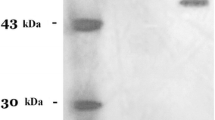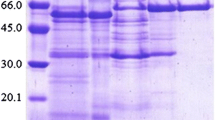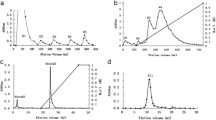Abstract
Naringinase fromAspergillus niger shows α-L-rhamnosidase and β-D-glucosidase activity. The ratio of these enzymatic activities varies, depending on the protein concentration as well as thepH. The rhamnosidase activity is nearly independent of thepH in the range from 3 to 7, whereas glucosidase shows a distinct optimum which varies betweenpH4 andpH6 depending on its pretreatment. By gel filtration the enzyme complex can be separated into various oligomers, which are multiples of the smallest active subunit with a molecular weight of 95 000. The oligomers show either both enzymatic activities or mere rhamnosidase action. Protein fractions with glucosidase activity only could not be isolated. However in fractions with rhamnosidase activity only, the glucosidase activity could be restored by immobilisation. Glucosidase activity is related to the concentration of protein in solution, disappearing in very diluted solutions, where rhamnosidase is still active.
Zusammenfassung
Naringinase ausAspergillus niger zeigt α-L-Rhamnosidase- und β-D-Glucosidaseaktivität. Das Verhältnis von Rhamnosidase- und Glucosidaseaktivität im Enzymkomplex kann sich verändern und hängt von der Proteinkonzentration und dempH ab. Die Rhamnosidaseaktivität des Enzymkomplexes zwischenpH3 undpH7 ist nahezu konstant, während die Glucosidase ein deutliches Optimum besitzt, das allerdings je nach Vorbehandlung zwischenpH4 undpH6 schwanken kann. Durch Gelfiltration kann der Enzymkomplex in verschiedene Oligomere aufgetrennt werden. Alle Fraktionen sind Vielfache der kleinsten aktiven Einheit (M=95 000) und besitzen entweder beide Enzymaktivitäten oder nur Rhamnosidaseaktivität. Aktive Glucosidase allein konnte nicht isoliert werden. Durch Immobilisierung kann jedoch in Proteinfraktionen mit reiner Rhamnosidaseaktivität wieder totale Naringinaseaktivität induziert werden. Die Glukosidaseaktivität ist abhängig von der Proteinkonzentration und verschwindet in sehr verdünnten Lösungen, während die Rhamnosidase unter diesen Bedingungen aktiv bleibt.
Similar content being viewed by others
References
Shintaro Kamiya, Sachiko Esaki, Misao Hama, Agr. Biol. Chem. (Tokyo)31, 142 (1967).
Danji Nomura, Keiji Akiyama, Nippon Shokuhin Kogyo Gakkaishi11, 267 (1964).
Shigetaka Okada, Mayumi Yano, Junichiro Fukumoto, Nippon Nogei Kagaku Kaishi38, 246 (1964).
Dunlap W. J., Hagen R. E., Wender S. H., J. Food Sci.27, 597 (1962).
Jacobs S., Nature183, 262 (1959).
Habelt K., Pittner F., Analyt. Biochem.134, 393 (1983).
Le Rosen A. L., Moravek R. T., Carlton J. K., Anal. Chem.24, 1335 (1952).
Tyihak E., Vaguifalvi D., Hagony P. L., J. Chromatogr.11, 45 (1963).
Anfärbereagenzien für Dünnschicht- und Papierchromatographie. E. Merck. Darmstadt: 1970.
Weetall H., in: Methods Enzymol., Vol. 44 (Mosbach K., ed.), p. 134. New York: Academic Press. 1976.
Pittner F., Miron T., Pittner G., Wilchek M., J. Solid Phase Biochem.5, 167 (1980).
Andrews P., Biochem. J.96, 595 (1965).
Maurer H. R., Diskelektrophorese. Berlin: W. de Gruyter. 1968.
Laemmli U. K., Nature227, 680 (1970).
Weber K., Pringle J. R., Osborn M., in: Methods Enzymol. Vol. 26c (Hirs C. H. W., Timasheff S. N., eds.), p. 3. New York: Academic Press. 1973.
Wray W., Boulikas T., Wray V. P., Hancock R., Analyt. Biochem.118, 197 (1981).
Shigetaka Okada, Mayumi Yano, Junichiro Fukumoto, Hakko Kyokaishi22, 371 (1964).
Kiyoshi Kishi, Kagaku to Kogyo33, 185 (1959).
Polyacrylamide Gel Electrophoresis Laboratory Techniques (revised ed.), p. 54. Upsala: Pharmacia Fine Chemicals.
Smythe C. V.,Thomas D. W., U.S. 2.950.974 (1960).
Andrews P., Biochem. J.96, 595 (1965).
Andrews P., in: Protides of the Biological Fluids, Vol. 14 (Peters H., ed.), p. 573. Amsterdam: Elsevier. 1967.
Andrews P., in: Methods of Biochemical Analysis, Vol. 18 (Glick D., ed.), p. 33. New York: Interscience, J. Wiley & Sons. 1970.
Pazur J. H., Knull H. R., Simpson D. L., Biochem. Biophys. Res. Comm.40, 110 (1970).
Bettelheim F. A., Biochim. Biophys. Acta236, 702 (1971).
Author information
Authors and Affiliations
Additional information
Dedicated to Professor Dr.Karl Schlögl at the occasion of his 60th anniversary.
Rights and permissions
About this article
Cite this article
Roitner, M., Schalkhammer, T. & Pittner, F. Characterisation of naringinase fromAspergillus niger . Monatsh Chem 115, 1255–1267 (1984). https://doi.org/10.1007/BF00809356
Received:
Accepted:
Issue Date:
DOI: https://doi.org/10.1007/BF00809356




